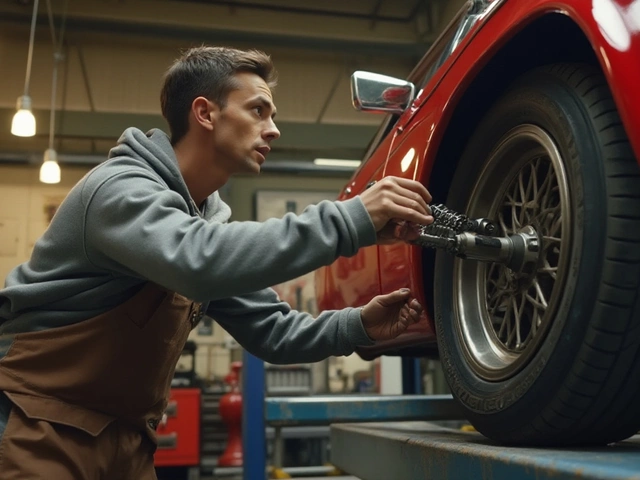When it comes to car modifications, lowering the suspension is a change that draws attention on the road. The sleek look and potential performance benefits can turn heads, but it isn't just about appearances. Dropping your car's height by a couple of inches could enhance its cornering ability and aerodynamics—a tempting offer for many car enthusiasts. However, before making the leap, there are important aspects to ponder.
Adjusting a car's ride height, especially by about two inches, involves weighing various benefits against possible drawbacks. From the excitement of improved handling to the worthiness of sacrificing comfort and the risk of scraping, it’s crucial to educate yourself thoroughly. Whether you’re in it for the aesthetics or the performance boost, understanding what lowering springs contribute to your ride is essential. Let's dive into what you need to know about taking your car a notch closer to the ground.
- Why Lower Your Car?
- Impacts on Performance and Comfort
- Challenges of Ground Clearance
- Choosing the Right Lowering Springs
- Tips for Safe and Effective Lowering
Why Lower Your Car?
Deciding to lower your car isn't merely about altering its silhouette; it's a calculated move aimed at revamping a vehicle's performance and appeal. Car aficionados often rave about how lowering a car does wonders for its stability, thanks to the lower center of gravity. This adjustment not only enhances grip during sharp turns but also reduces body roll, making for a more engaging ride. And it's these enhanced dynamics that racing teams and sports car manufacturers chase after, translating into more confident handling whether cruising the streets or hitting the track. The allure of lowering a vehicle isn’t confined to performance alone—it’s equally about those aesthetic gains.
The minimalist gap between the tire and wheel arch creates a more aggressive stance, like a predator crouched and ready to pounce, which captures the imagination of onlookers and fellow car enthusiasts. This sleek, refined look is thanks to modifications such as lowering springs that offer that desired drop, setting your ride apart from the multitudes. There’s a transformational power in visually reducing that space; it can make a ten-year-old car appear fresh and contemporary, conveying a sense of speed and precision even at a standstill.
Let's take a break for a moment to reflect on expert opinions.
Renowned automotive journalist Chris Harris once said, "A lowered car is an art form on wheels. It tells a story of a driver with purpose—a balance between passion and performance."His words capture the essence of why lowering one's vehicle is so deeply rewarding for many. The aesthetic transformation is undeniable, but the passion lies in the journey of merging style with measurable improvements in driving feel.
Yet, the decision to lower a car isn't one to take lightly. It demands a keen understanding of variables beyond cosmetics and performance. While many individuals relish showing off their impressively low vehicles at car meets, it’s crucial to anticipate the practicalities of everyday driving. How will your now-lowered car navigate speed bumps that litter urban landscapes like secret mines? Will you still be able to drive up your steep driveway without cringing with each scrape? These are practical lines of inquiry that every discerning car owner must address before committing to the change. In fact, lowering a car often requires recalibrating with new equipment or components like adjustable camber kits to preserve tire wear and balance.
Keep in mind, the number of inches you drop can have repercussions across different driving scenarios. For those using their cars for regular commutes aside from weekend cruises, the key is finding that sweet spot where your car modification translates effectively across different use cases. This requires considering both quality and compatibility of the parts being installed—certainly no small detail when longevity and safety come into play. By weighing all these factors, car enthusiasts can truly capitalize on the full spectrum of benefits that come from that crucial two-inch drop.
Impacts on Performance and Comfort
Lowering your car by two inches isn't just for showing off on the city streets; it plays a significant role in how your vehicle interacts with the road. One of the immediate benefits enthusiasts seek is the enhanced vehicle performance. By bringing the car's center of gravity closer to the ground, you improve its handling. This is especially beneficial when navigating sharp corners or driving at high speed as the chance of body roll is significantly reduced. A lowered car often feels more planted and responsive, almost like it's an extension of your will as its driver. This can be attributed to the improved aerodynamics that come with a closer ground clearance, reducing drag and allowing for potential fuel savings.
However, with these benefits also come some trade-offs. Comfort is a key area where drivers might feel the pinch. A car that's been lowered by two inches will inevitably provide a firmer ride experience. Lowering springs aren't always designed with luxury in mind, so every bump and crack in the road is communicated with greater clarity through the car's suspension. This can get tiring on long road trips or over less-than-perfect roads. It's a matter of personal preference; some find it thrilling, feeling every nuance of the road, while others may find it jarring. The choice of lowering springs can affect this drastically, with some brands focusing on maintaining ride comfort while others prioritize performance above all else.
Ground clearance needs careful consideration, as lowering affects not just the car's performance but also its practicality. Curbs, speed bumps, or even steep driveways become potential hazards, often requiring adjustments to driving habits to avoid scraping the undercarriage.
According to Car and Driver, "A lowered car demands respect from its driver. It asks for foresight in maneuvering and planning your approach on uneven surfaces."This not only involves careful driving but can also mean further modifications if scraping becomes an issue, such as investing in aftermarket skid pads or lift kits for traversing obstacles.
To help illustrate the balance between performance and comfort, consider the following: a study conducted on vehicles with varied suspension tuning demonstrated that cars lowered by significant heights typically saw a 5-10% improvement in cornering speeds. Yet, drivers reported an increase in perceived road surface harshness by a similar margin. This highlights the clear trade-off between sport-like handling capabilities and day-in-day-out drivability, especially on cars that are put through their paces outside racing circuits.
Ultimately, the impact on performance and comfort boils down to individual expectations and daily use. If your journey is primarily urban with perfect roads and minimal hurdles, a lowered car might suit your lifestyle. However, if you often find yourself driving in areas where road conditions can be unpredictable or if comfort tops your list of priorities, it's crucial to weigh these changes against your needs. Personal taste, the quality of roads you frequently travel, and whether the performance gains align with how you drive will inform if such a modification feels worth its literal weight in metal.

Challenges of Ground Clearance
Lowering your vehicle by two inches often results in a noticeable change in ground clearance, presenting a mix of excitement and possible headaches for any car enthusiast. The lower profile can enhance the aesthetic appeal of your vehicle, giving it a sporty look. However, the reduction in height comes with its set of challenges. One of the most notable issues is navigating speed bumps and steep driveways. These common terrain features, otherwise inconsequential for a regular car, can pose a real problem when your car hugs the pavement a little too closely. Scraping the bottom of your car doesn’t just cause superficial damage; it can impact vital components underneath, like the exhaust system or oil pan.
Beyond urban obstacles, lowered cars need to contend with the variations in road conditions. Potholes and uneven surfaces become more than mere inconveniences—they are potential risks to your car’s undercarriage. This particular aspect of lowering cars often brings about debates among enthusiasts. Complexity arises when performance driving is desired on suburban streets where minor road imperfections can be hazardous. As such, it is essential to weigh the risks of everyday driving against any potential gains in handling precision.
Having less clearance may also interfere with the aerodynamic benefits many seek through lowering. While the reduced height brings the car closer to aerodynamic bliss by decreasing lift, contact with the road can phenomenally disrupt airflow. It underscores the need for careful adjustment balance to reap the rewards without falling prey to disadvantages.
“The art of lowering a car successfully is all about finding that sweet spot where aesthetics aligns harmfully with functionality; otherwise, the trade-off can be just not worth it,” says renowned auto-enthusiast and engineer, Alex Rowan.
There’s also the inevitable issue of tire rub, where tires may scrape against the car’s body or suspension components due to the reduced space. Ensuring that your car’s wheels are properly aligned and spaced becomes critical to maintain both performance and safety. It’s not just the ride height that comes under scrutiny; suspension tuning also plays a significant role. When springs are cut or replaced without appropriate care, the car’s suspension geometry can be misaligned. Such misalignment not only affects the ride quality but might lead to premature tire wear and more complex suspension issues.
To accommodate these alterations, drivers need to be more vigilant about routine checks and heightened maintenance demands. Regular inspections of the car’s underside to monitor any wear and tear can help mitigate future structural damage. Moreover, investing in high-quality lowering springs and ensuring proper installation can alleviate some ground clearance issues. While this commitment to regular maintenance can be more demanding, many enthusiasts feel it is a fair trade for the benefits enjoyed from a lowered stance. A vital part in making an informed decision is understanding the scope of commitment involved in adapting your daily driving habits and the maintenance practices to suit a modified ride height.
Choosing the Right Lowering Springs
Investing in the right lowering springs is crucial for achieving the balance between performance and ride comfort you desire. These springs aren't merely about aesthetics; they are the backbone of your car's new height and, consequently, impact its behavior on the road. When considering what suits best for your vehicle, you must look at a variety of factors, including compatibility, spring rate, and cost.
Compatibility is the first box to tick when selecting lowering springs. The springs must be engineered for your car's make, model, and year to ensure they fit properly without forcing any undesirable modifications. Improper fitment could lead to a compromised suspension system or even damage to other components. It is worth checking with manufacturers or consulting vehicle-specific forums to gather real-world insights from fellow car enthusiasts. Learning from someone who has already been through the process could be beneficial in avoiding common pitfalls.
"Good springs aren't just cut and fit; they are an engineering marvel tailored to each car's needs," says Jan Muller, a veteran automotive engineer.
Spring rate plays a pivotal role and refers to the amount of weight required to compress the spring by one inch. Higher spring rates typically translate to stiffer suspension and improved handling, leading to a more responsive driving experience. However, stiffer springs often mean a harsher ride, which might not suit daily drivers who prioritize comfort. Balancing spring rates can be tricky; thus, testing and adjustment might be required until you find a combination that works perfectly for you and your car. Consulting with a professional can provide valuable guidance tailored to your specific driving habits and preferences.
Cost invariably factors into every decision. Lowering springs come in various price ranges, influenced by material quality and brand reputation. It's tempting to opt for cheaper options; however, investing in well-reviewed, quality springs could save you money in the long run by avoiding repetitive replacements or repair costs due to damage caused by inferior parts. Remember, the choice of springs should match, rather than exceed, the performance of your vehicle. Look for springs made from high-tensile steel or similar materials known for durability and consistent performance.
Another consideration is the amount of drop produced by the springs. While we might aim for significant lowering, remember that going too low could result in adverse effects such as scraping on speed bumps or poor handling on uneven surfaces. Typically, a 1 to 2-inch drop is considered safe for maintaining practicality without sacrificing too much of drivability. Some experience minimal practical difference, while others might perceive a significant change in how their car feels. Ensuring your vehicle's other components, like shocks and struts, can handle the new ride height is also essential, as they support the overall suspension system.
Here’s a quick glance at different types of lowering springs, which you could consider based on your driving needs:
- Progressive Springs: Offer versatility as they adjust the spring rate based on driving conditions, ideal for those who need a blend of daily comfort and occasional sporty handling.
- Linear Springs: Provide a consistent spring rate. Good for track use where the driver anticipates regular performance without much variability.
- Sport/Racing Springs: These are typically more aggressive in terms of lowering and spring rate, favored by enthusiasts who prioritize performance over comfort.
Finding the right lowering springs is about aligning your car's potential with your driving expectations. Doing homework, seeking expert advice, and balancing factors like compatibility, spring rate, and cost will pay off in the experience behind the wheel. Take your time; after all, this is about turning your car into a better version of itself.

Tips for Safe and Effective Lowering
Dropping your car a couple of inches with lowering springs isn't just an enthusiastic nod to style. It's both an art and necessity that demands understanding and careful execution. The first step towards effective lowering is assessing whether your car's present setup and wheels can justify a 2-inch dip. This isn't merely about aesthetics; the suspension system's integrity, the car's alignment, and even the tires' longevity are at stake. So, before you start purchasing parts or wrenching in your garage, it'd be wise to consult with a professional mechanic or a suspension expert who can provide invaluable insights tailored to your vehicle.
Once you have an expert's nod, it's crucial to choose the right springs and suspension components. Not all springs are created equal and picking a set specifically designed for your car's make and model ensures compatibility and desired performance. Quality lowering springs not only offer better alignment but they also last longer, reducing the likelihood of premature sagging or failure. Keep an eye on their spring rate; it determines the stiffness of the ride. While softer springs may tempt the comfort-seekers, they often result in less precise handling, which might rob you of the performance edge you’re aiming for.
Car modification isn't an overnight venture, and world-class mechanics advise proceeding with informed caution. As renowned automotive engineer Alex Jennings put it,
"One must respect the balance between the aesthetics of a lower stance and the functionality required for everyday drives."When diving into adjustments, it's key to understand the interplay between springs, shocks, and struts. A performance lowering job may call for additional replacement or upgrading of these components to maintain a balanced, secure setup.
After the physical installation of lowering springs, remember to follow up with a comprehensive alignment check. Lowering a vehicle disrupts its stock alignment specifications and can result in uneven tire wear and compromised handling. Professional alignment ensures optimal contact patch with the road and restores factory-like ride quality. Lastly, take your modified vehicle for a test ride under various conditions. It allows you to ascertain if the lowering springs have met your expectations. Adjust if necessary, especially if you encounter unexpected scraping or difficulties navigating inclined surfaces.
Importantly, always keep your vehicle in top condition with periodic checks. Aftermarket modifications can sometimes lead to extra maintenance requirements. An inclined workshop with aftermarket experience can be your best partner in this journey, ensuring your car remains boast-worthy and, more importantly, safe on the road.




